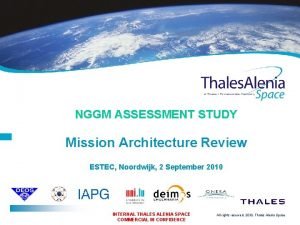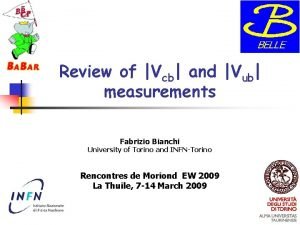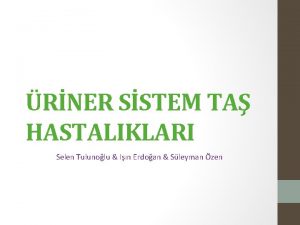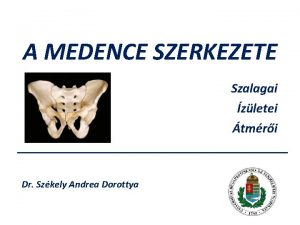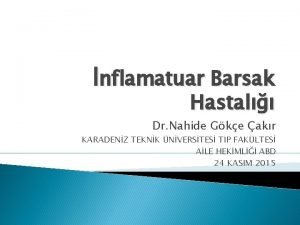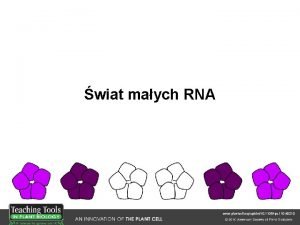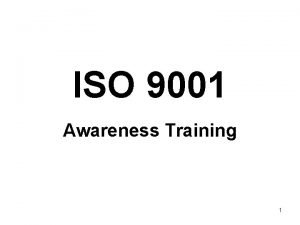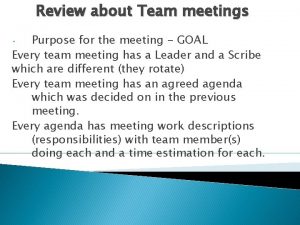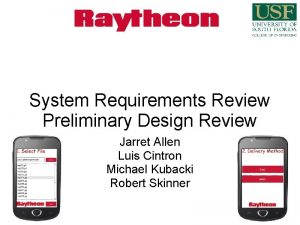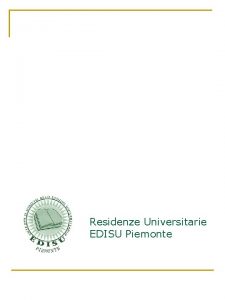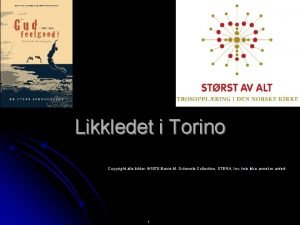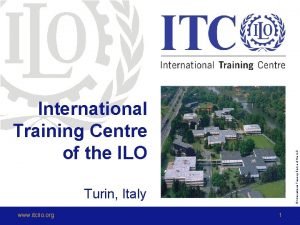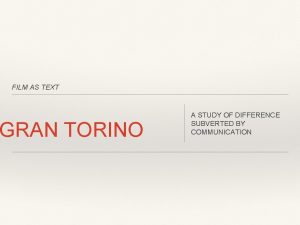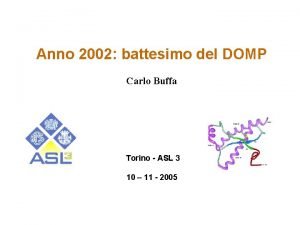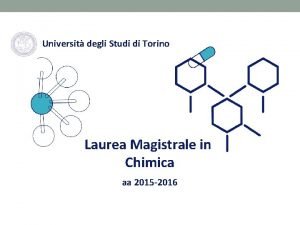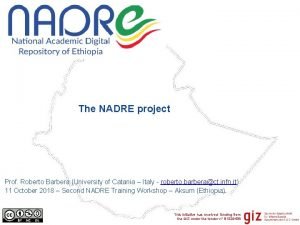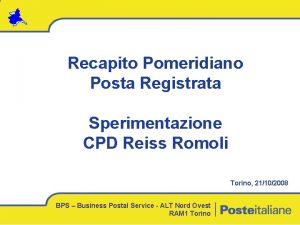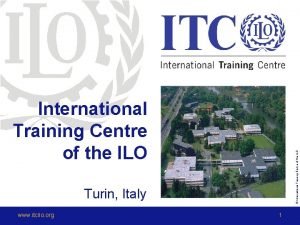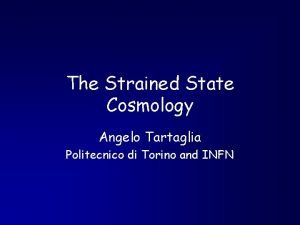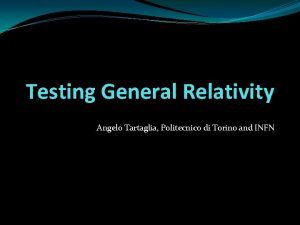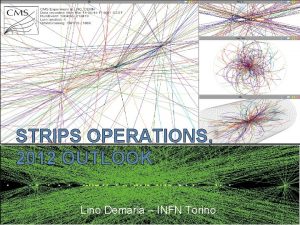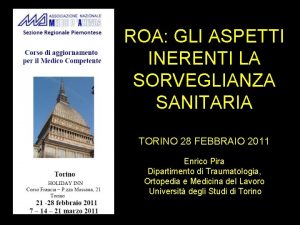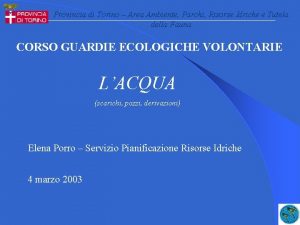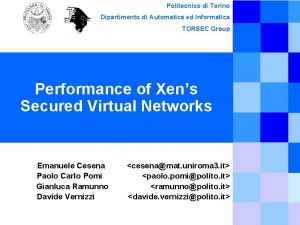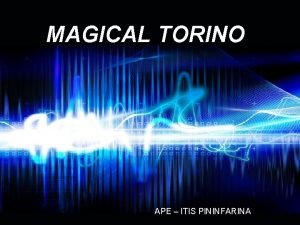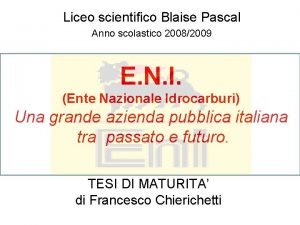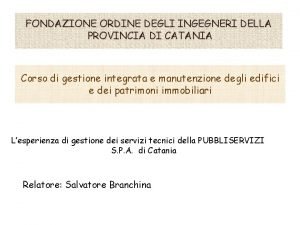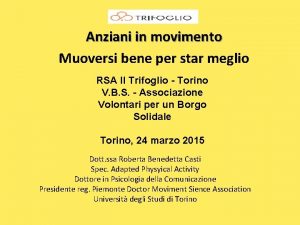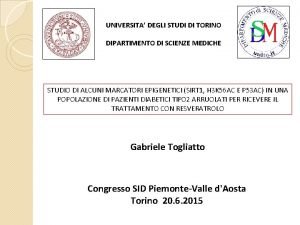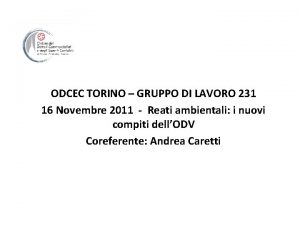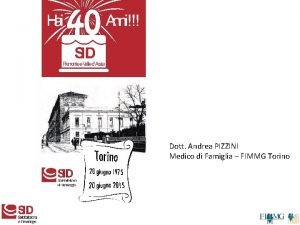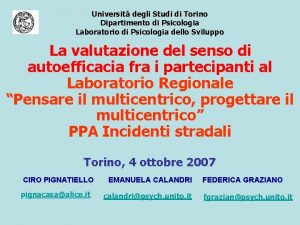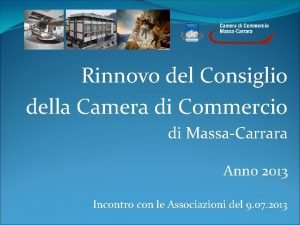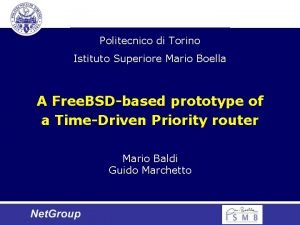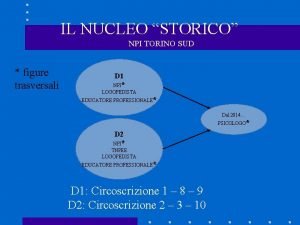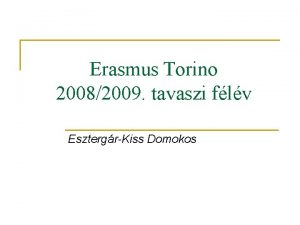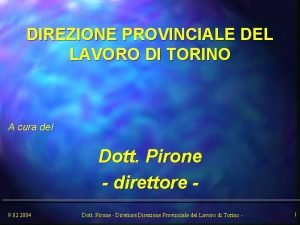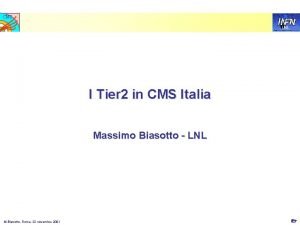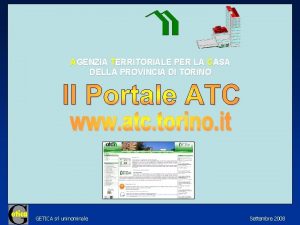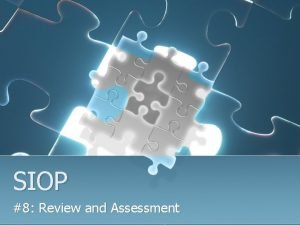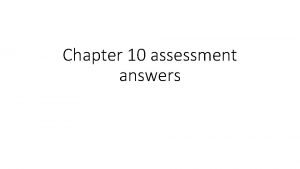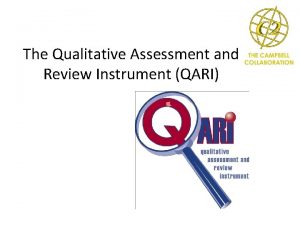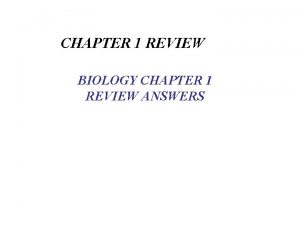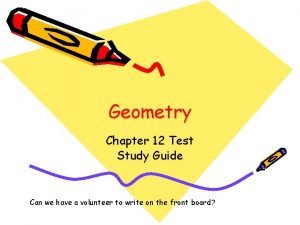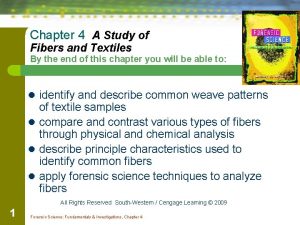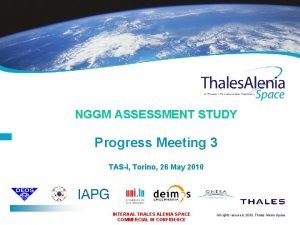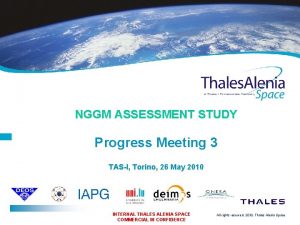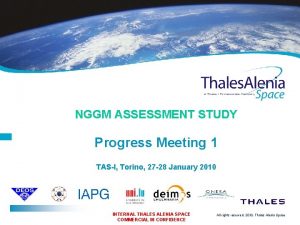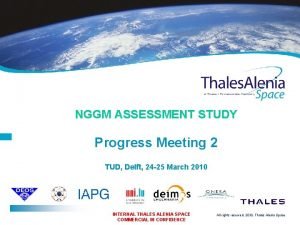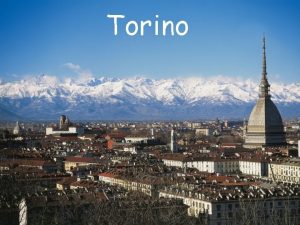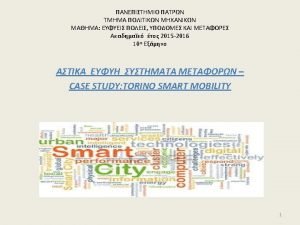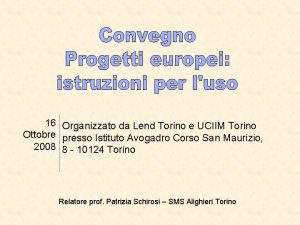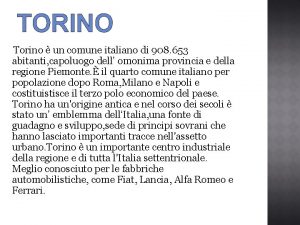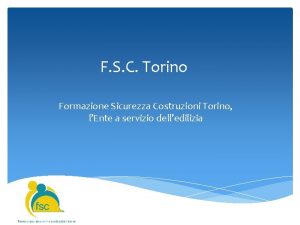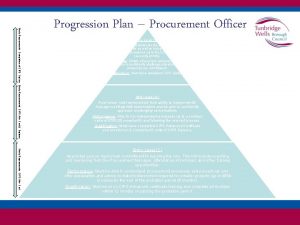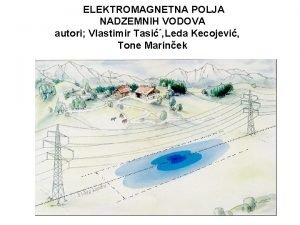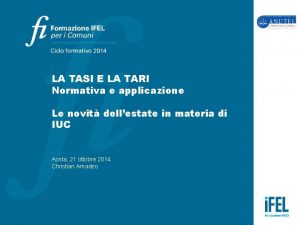NGGM ASSESSMENT STUDY Requirements Review Meeting TASI Torino




































































![Candidate system architectures [all with laser SST] Page 69 NGGM Assessment Study 19 November Candidate system architectures [all with laser SST] Page 69 NGGM Assessment Study 19 November](https://slidetodoc.com/presentation_image_h2/b0abf69cc56e96877933d6211743305f/image-69.jpg)















- Slides: 84

NGGM ASSESSMENT STUDY Requirements Review Meeting TAS-I, Torino, 19 November 2009 INTERNAL THALES ALENIA SPACE COMMERCIAL IN CONFIDENCE All rights reserved, 2009, Thales Alenia Space

Agenda Page 2 9: 00 Welcome and Introduction 9: 15 WP 1100: Requirements Analysis (ULUX) current status of satellite gravimetry wrt detection of mass transport in the Earth System scientific questions potentially addressed by improvements in spatial / temporal resolution analysis of current limitations with respect to aliasing and background models list of priorities for the NGGM 13: 00 Lunch break 14: 00 WP 1200: System drivers (TAS-I) Payload engineering requirements and constraints Satellite platform drivers Mission architecture options Cost/performance models 15: 30 WP 2310: E 2 E Simulator progress report (TAS-I) 15: 45 WP 2320: Variable Gravity Model progress report (IAPG) 16: 00 Discussion, work plan 17: 00 End of meeting NGGM Assessment Study 19 November 2009 INTERNAL THALES ALENIA SPACE COMMERCIAL IN CONFIDENCE All rights reserved, 2009, Thales Alenia Space

Page 3 WP 1200: System Drivers Payload engineering requirements and constraints NGGM Assessment Study 19 November 2009 INTERNAL THALES ALENIA SPACE COMMERCIAL IN CONFIDENCE All rights reserved, 2009, Thales Alenia Space

Earth gravity measurement techniques Page 4 Satellite gradiometry (GOCE) Fundamental observables: components of the gravity gradient (Vxx, Vyy, Vzz, Vxy, Vxz, Vyz) measured by the gradiometer as difference between the accelerations at the location of any accelerometer pair divided by the pair baseline. NGGM Assessment Study 19 November 2009 Low-low satellite-to-satellite tracking (GRACE) Fundamental observable: distance variation between two satellites produced by the gravity acceleration: d. G, obtained as d - d. D d: distance variation between the two satellites produces by any source, measured by a laser metrology system. d. D: distance variation between the satellites produced only by drag forces, measured by accelerometers. INTERNAL THALES ALENIA SPACE COMMERCIAL IN CONFIDENCE All rights reserved, 2009, Thales Alenia Space

Gradiometry vs LLSST Page 5 Why LLSST is more suitable than gradiometry to measure temporal variations of the Earth gravity field LLSST, thanks to the much larger separation between the “proof masses” (the satellites themselves) is intrinsically more sensitive than gradiometry. Therefore good measurement accuracy can be achieved even at the relatively high altitudes (>300 km) needed to ensure long lifetime with an affordable amount of propellant. NGGM Assessment Study 19 November 2009 INTERNAL THALES ALENIA SPACE COMMERCIAL IN CONFIDENCE All rights reserved, 2009, Thales Alenia Space

Measurement instruments Page 6 Instruments involved in the measurement of the fundamental observable ( d. G) in a LLSST mission. NGGM Assessment Study 19 November 2009 INTERNAL THALES ALENIA SPACE COMMERCIAL IN CONFIDENCE All rights reserved, 2009, Thales Alenia Space

Distance measurement scheme Page 7 Distance measurement objective: Measurement of the distance variation ( d) between the satellite COMs. Involved P/L items: Distance metrology, Angle metrology, Lateral metrology Distance metrology (laser based) function: q Measurement of the distance variation between the retro-reflectors (points A, C) along the optical path followed by the laser beam (A-B-C): L = d 1 + d 2. Angle metrology function: q Measurement of rotation angles of Satellite 1, 2 w. r. t. the line joining the satellite COMs ( laser beam): 1, 2, 1, 2 Lateral displacement metrology function: q Measurement of RR 2 Y-Z offsets from laser beam axis, for beam pointing. NGGM Assessment Study 19 November 2009 INTERNAL THALES ALENIA SPACE COMMERCIAL IN CONFIDENCE All rights reserved, 2009, Thales Alenia Space

Distance metrology concepts Retro-reflection concept Page 8 Optical transponder concept Proposed/developed in US for GRACE-FO Proposed/developed by TAS-I for NGGM Michelson-type heterodyne interferometer based Michelson-type heterodyne interferometer with on transceiver scheme with master laser on passive retro-reflection and chopped laser satellite 1 and slave laser on satellite 2 phasebeam for long-distance (> ~1 km) operation. locked to the first one in “frequency-offset”. Pros: single laser sufficient to perform the Pros: suitable for very long distances (>100 km) measurement (-complexity, +reliability). Two thanks to the signal “re-generation” scheme. lasers provides the single-failure tolerance. Cons: two lasers and two interferometers must Cons: unsuitable for very long distances (> 100 operate simultaneously (+complexity, -reliability) km) due to the weak return optical power. NGGM Assessment Study 19 November 2009 INTERNAL THALES ALENIA SPACE COMMERCIAL IN CONFIDENCE All rights reserved, 2009, Thales Alenia Space

Distance measurement errors Page 9 Distance measurement error tree (values from the previous study) NGGM Assessment Study 19 November 2009 INTERNAL THALES ALENIA SPACE COMMERCIAL IN CONFIDENCE All rights reserved, 2009, Thales Alenia Space

Distance measurement limit Page 10 Ultimate limiting factor: laser frequency stability L = distance measured by the laser = laser frequency (~282 THz) Best frequency stability achieved in laboratory using a reference cavity (not easy). Ref. Gerhard Heinzel, “LISA technology for gravity-field missions”, Graz Workshop, 30/9 2009. NGGM Assessment Study 19 November 2009 Envelope Error contribution of the laser frequency stability only INTERNAL THALES ALENIA SPACE COMMERCIAL IN CONFIDENCE All rights reserved, 2009, Thales Alenia Space

Distance measurement requirement Page 11 Top-level requirement considered in the previous study Assumed best performance on the COM-COM distance d overall relative error achievable in orbit. Corresponding requirement on distance measurement error ( d), for d = 10 km. 5 nm/ Hz NGGM Assessment Study 19 November 2009 INTERNAL THALES ALENIA SPACE COMMERCIAL IN CONFIDENCE All rights reserved, 2009, Thales Alenia Space

Ancillary metrology requirements Page 12 Lateral displacement metrology Angle metrology Measurement of the laser beam axis lateral displacements relative to the retro. Measurement of the S 1, S 2 rotation reflector on S 2, such as to ensure a laser angles w. r. t. the line joining the satellite beam pointing control with: COMs ( laser beam): i, i q max. error 10 -5 rad ( 0. 1 m at 10 km). q measurement range: 1° q maximum measurement error 10 -4 rad q pointing stability spectral density: q measurement error spectral density 10 -7 rad/ Hz 1. 5 10 -7 rad/ Hz Lateral displacement measurement noise 10 -3 m/ Hz at 10 km). NGGM Assessment Study 19 November 2009 INTERNAL THALES ALENIA SPACE COMMERCIAL IN CONFIDENCE All rights reserved, 2009, Thales Alenia Space

Laser power impact on distance metrology Page 13 Output optical power of the laser source set = 0. 75 W in the previous NGGM study. Case 1: same distance measurement error ( d = 5 nm/ Hz) for any distance. Case 2: same distance relative measurement error d/d = 5 10 -13 1/ Hz) for any distance. Optical power received by the laser interferometer (after the retro-reflection) vs inter-satellite distance, compared with minimum power requirement in Case 1, 2. NGGM Assessment Study 19 November 2009 INTERNAL THALES ALENIA SPACE COMMERCIAL IN CONFIDENCE Optical power requirement fulfilled up to ~85 km in Case 1 and up to >100 km in Case 2. Conclusion: the distance metrology based on the retro-reflector is still limited by the laser frequency stability ( / = L/L) and not by the optical power. All rights reserved, 2009, Thales Alenia Space

Distance measurement: required resources Page 14 S/C resources/services (preliminary) required by the measurement system (Distance, Angle, Lateral metrology). distance Mass: 60 kg (including optical bench) Power demand: 100 W Telemetry generation rate: 1. 5 kbps (distance + angle metrology; data output at 10 Hz) Inter-satellite telemetry rate: 3 kbps (lateral metrology on S 2: data output at 100 Hz) On board processing power: ~20000 flops (mainly on S 1 for distance metrology + beam pointing management). Large amount of the computation on the distance metrology and angle/lateral metrology shall be performed by a dedicated FPGA/ASIC. ~10000 flops are required by the pointing control. Absolute / Relative Pointing Error: not very demanding if the laser beam pointing function is performed by a dedicated device and not by the S/C. Relative velocity control: <15. 9 m/s (limited by the heterodyne frequency) Relative acceleration control: <120 m/s 2 (limited by the laser beam chopping scheme) Other: stable thermal control on the optical bench and on for the optical cavity utilized for the laser frequency stability NGGM Assessment Study 19 November 2009 INTERNAL THALES ALENIA SPACE COMMERCIAL IN CONFIDENCE All rights reserved, 2009, Thales Alenia Space

Distance measurement system: Alternative architectures Page 15 Alternative 1: distance metrology without laser frequency stabilization Distance variation measurement error computed for d = 10 km. Ref. M. Tröbs et al. , Laser development for LISA, Class. Quantum Grav. 23 (2006) S 151–S 158 The frequency stabilization system has a significant impact in cost (~2 x) and complexity (frequency reference, closed loop control) on the distance measurement system, but is unavoidable to improve the GRACE performance. NGGM Assessment Study 19 November 2009 INTERNAL THALES ALENIA SPACE COMMERCIAL IN CONFIDENCE All rights reserved, 2009, Thales Alenia Space

Distance measurement system: Alternative architectures Page 16 Alternative 2: laser beam pointing performed by the S/C attitude control Advantages of a dedicated laser beam pointing device: More relaxed attitude control requirements. Satellite attitude control decoupled from the relative motion of the satellites. Drawbacks of a dedicated laser beam pointing device: More complexity and less reliability (mechanism continuously operating) Induced disturbances on distance measurement and potentially on accelerometers. Conditions for transferring the laser beam pointing task to the S/C attitude control: Relaxation (~10 x, TBC) of the current requirements on laser beam pointing and stability (10 -5 rad, 10 -7 rad/ Hz). Attitude motion induced by the tracking of Satellite 2 compatibility with attitude stability requirements NGGM Assessment Study 19 November 2009 INTERNAL THALES ALENIA SPACE COMMERCIAL IN CONFIDENCE All rights reserved, 2009, Thales Alenia Space

Distance measurement system: Alternative architectures Page 17 Alternative 3: angle metrology replaced by S/C equipments (GPS, star trackers) The satellite rotation angles w. r. t. the line joining the satellite can be obtained in principle using: The satellite absolute and relative position provided by the GPS, from which the inertial orientation of the satellite-to-satellite line can be reconstructed. The inertial attitude of each satellite provided by the star trackers. Condition for replacing the angle metrology with GPS and star trackers: Relaxation by at least one order of magnitude (TBC) the measurement error spectral density (set to 1. 5 10 -7 rad/ Hz in the previous NGGM study). Possible increase (TBC) of the laser beam divergence (currently 10 -4 rad). Note: in case the beam pointing device will be removed (and therefore there are no bending of the laser beam outgoing/incoming from/to S 1), the nearly constant rotation angles of S 1 relative to the beam ( satellite-to-satellite line) could be performed using a quadrant photodiode in the laser interferometer (same concept of GRACE-FO metrology). NGGM Assessment Study 19 November 2009 INTERNAL THALES ALENIA SPACE COMMERCIAL IN CONFIDENCE All rights reserved, 2009, Thales Alenia Space

Non-gravitational acc. measurement scheme Page 18 Non-gravitational acceleration measurement objective: Measurement of the non-gravitational differential acceleration of the two satellites along the line joingin the COMs: d. D = Involved P/L items: Accelerometers, Angle metrology Accelerometers function: q Measurement of the non-gravitational, linear acceleration of the COM of each satellite, in the Satellite Reference Frame: D 1 , D 2. Angle metrology function: q Measurement of rotation angles of Satellite 1, 2 Reference Frames w. r. t. the line joining the satellite COMs: 1, 2, 1, 2 NGGM Assessment Study 19 November 2009 INTERNAL THALES ALENIA SPACE COMMERCIAL IN CONFIDENCE All rights reserved, 2009, Thales Alenia Space

Non-gravitational acc. measurement Page 19 Non-gravitational differential acceleration measurement error tree (values from the previous study) NGGM Assessment Study 19 November 2009 INTERNAL THALES ALENIA SPACE COMMERCIAL IN CONFIDENCE All rights reserved, 2009, Thales Alenia Space

Non-gravitational acc. measurement Page 20 Ultimate limiting factor: accelerometer intrinsic noise GOCE accelerometer noise along the ultra-sensitive axes considered the ultimate performance limit (note GRACE acc. noise = 10 -10 m/s 2/ Hz). Non-gravitational acceleration noise increase at high frequency matched to the double time derivative of the distance variation measurement noise. Top-level requirement considered in the previous study NGGM Assessment Study 19 November 2009 INTERNAL THALES ALENIA SPACE COMMERCIAL IN CONFIDENCE All rights reserved, 2009, Thales Alenia Space

Angle Metrology Requirement Page 21 Derived requirements from Transformation Errors Satellite misalignment in the SSRF: P, P 1° Rotation angle measurement error: P, P 10 -4 rad Envolope of satellite pointing requirements from distance variation measurement and non-gravitational acceleration measurement: , 1°, , 10 -4 rad • Satellite rotations stability requirements • Satellite rotation meas. error requirements NGGM Assessment Study 19 November 2009 October 21 2008 INTERNAL THALES ALENIA SPACE COMMERCIAL IN CONFIDENCE All rights reserved, 2009, Thales Alenia Space

Acceleration measurement: required resources Page 22 S/C resources/services (preliminary) required by the acceleration measurement system (two GOCE-like accelerometers per S/C assumed). Mass: 22 kg Power demand: 35 W Telemetry generation rate: 3 kbps (3 linear + 3 angular accelerations per accelerometer; data output at 10 Hz) Drag free control in linear and angular accelerations: Linear acceleration max. value 1 10 -6 m/s 2 NGGM Assessment Study 19 November 2009 Angular acceleration max. value: 1 10 -6 rad/s 2 INTERNAL THALES ALENIA SPACE COMMERCIAL IN CONFIDENCE All rights reserved, 2009, Thales Alenia Space

Distance measurement system: Alternative architectures Page 23 S/C without drag-free control (just orbit maintenance) GOCE drag acceleration environment at ~255 km, low solar activity. • With a factor ~10 relaxation of the residual linear acceleration requirements, the drag control in radial and cross-track directions could be avoided ( benefit on thruster range), while it seems still necessary in-track (TBC by disturbance and performance analysis). • An attitude control finer than in GOCE ( 3 4º in yaw) is necessary to guarantee the optical link, even if a dedicated device is used for the laser beam pointing electrical thrusters needed since reaction wheels are too noisy for the accelerometers. NGGM Assessment Study 19 November 2009 INTERNAL THALES ALENIA SPACE COMMERCIAL IN CONFIDENCE All rights reserved, 2009, Thales Alenia Space

Page 24 WP 1200: System Drivers Satellite platform drivers NGGM Assessment Study 19 November 2009 INTERNAL THALES ALENIA SPACE COMMERCIAL IN CONFIDENCE All rights reserved, 2009, Thales Alenia Space

System drivers vs. practical limits Page 25 q Launcher type and number of launches q Physical configuration (mass, volume, shape) q Electrical power system design (solar array efficiency, power system density) q Thermal Control (complexity) q On board data handling (science data rates, ancillary data rates, mass memory size, on board processing power) q Telecommunications (inter-satellite data exchange, telemetry rates to ground station, frequency of contacts with ground station) q Orbit control (orbit maintenance needs, frequency, propellant budgets) q Attitude & drag free control (pointing accuracy, laser pointing control, linear and angular acceleration control) q Relative satellite motion (relative range control accuracy, formation keeping) NGGM Assessment Study 19 November 2009 INTERNAL THALES ALENIA SPACE COMMERCIAL IN CONFIDENCE All rights reserved, 2009, Thales Alenia Space

Launcher performance Page 26 Eurokot: 1250 kg in SSO (GOCE) Vega NGGM Assessment Study 19 November 2009 INTERNAL THALES ALENIA SPACE COMMERCIAL IN CONFIDENCE All rights reserved, 2009, Thales Alenia Space

Launcher volume & satellite shape Page 27 Prism-shaped satellite accommodation in VEGA Front cross section: 1. 1 m² Max lateral cross section: 7. 2 m² Min lateral cross section: 3. 2 m² Min lateral/front cross section ratio: 2. 9 Max lateral/front cross section ratio: 6. 5 Volume: 4. 48 m³ NGGM Assessment Study 19 November 2009 Flat-cylinder-shaped satellite [cartwheel / pendulum] Top surface = solar panel area: 3. 5 m² (Rockot), 4. 4 m² (VEGA) Height @ 1. 1 m² lateral cross section: 0. 52 m (Rockot), 0. 46 m (VEGA) Volume: 1. 8 m³ (Rockot), 2 m³ (VEGA) INTERNAL THALES ALENIA SPACE COMMERCIAL IN CONFIDENCE All rights reserved, 2009, Thales Alenia Space

Satellite shape in cross-line formations Page 28 Drag force rotating around the body suggests shape of a flat cylinder Pendulum q drag force scans 45° angular sector around satellite, once per orbit q cylindrical satellite with long axis aligned to local vertical always offers same cross section to drag q Minimum of 2 thrusters needed for drag compensation NGGM Assessment Study 19 November 2009 Cartwheel q drag force turns around satellite body once per orbit q cylindrical satellite with long axis aligned to orbit normal always offers same cross section to drag q Minimum of 4 thrusters needed for drag compensation INTERNAL THALES ALENIA SPACE COMMERCIAL IN CONFIDENCE All rights reserved, 2009, Thales Alenia Space

Satellite shape in cross-line formations Page 29 In high-i orbits, air density changes by factor of 3 from equator to poles → prismatic sat (variable cross section facing drag) Smaller cross section facing drag at equator (higher density) Larger cross section facing drag at poles (lower density) Prismatic shape for pendulum formation NGGM Assessment Study 19 November 2009 Prismatic shape for N-S cartwheel formation INTERNAL THALES ALENIA SPACE COMMERCIAL IN CONFIDENCE All rights reserved, 2009, Thales Alenia Space

Structure & Thermal Control Page 30 GOCE & GRACE: common drivers External shell as load-carrying structure Symmetry, aerodynamic shape Accurate Co. M trim Thermoelastic stability Comfortable mass margins throughout implementation phase GOCE design parameters (reference) Structure mass ratio: 33% [including 60 kg balance mass] Thermal control mass ratio: 3% GRACE (reference) Structure mass ratio: 50% [including 35 kg balance mass] Thermal control mass ratio: 3. 5% Implications for GRACE+ will continue to be driven by high structure mass ratio, aerodynamics, Co. M, thermoelastics mass margin likely to become a driver too (twin launch on Eurokot) NGGM Assessment Study 19 November 2009 INTERNAL THALES ALENIA SPACE COMMERCIAL IN CONFIDENCE All rights reserved, 2009, Thales Alenia Space

Electrical power system Page 31 GOCE design parameters (reference) SSO Max eclipse < 28 min hibernation during long eclipse Max power demand 1 k. W incl. IPA @ 19 m. N Max sun incidence angle on solar array 30 Solar array efficiency (all included) 150 W/m² [Ga. As cells] Power system density 7. 5 W/kg Power system mass fraction at launch 13% NGGM Assessment Study 19 November 2009 GRACE (reference) Non-SSO Max eclipse < 36 min Max power demand 160 W Solar array efficiency (all included) 32 W/m² [Si cells] Power system density 1. 5 W/kg Power system mass fraction at launch 28% Implications for GRACE+ Large increase of power demand (OM by ion propulsion + laser system) Mass increase (solar array & battery) Trade-off: solar array accommodation vs. operational limits INTERNAL THALES ALENIA SPACE COMMERCIAL IN CONFIDENCE All rights reserved, 2009, Thales Alenia Space

Electrical power system Page 32 GOCE IPA Power Demand (reference) NGGM Assessment Study 19 November 2009 INTERNAL THALES ALENIA SPACE COMMERCIAL IN CONFIDENCE All rights reserved, 2009, Thales Alenia Space

Power implications of non sun-syncronous orbit Page 33 Sun revolves around orbit plane → longer eclipses & eclipse seasons NGGM Assessment Study 19 November 2009 INTERNAL THALES ALENIA SPACE COMMERCIAL IN CONFIDENCE All rights reserved, 2009, Thales Alenia Space

Power implications of non sun-syncronous orbit Page 34 Electrical power from fixed solar panels insufficient for science+drag control → steerable solar array (cost) or seasonal degradation of performance example: GRACE-like formation, ~8 m² side panel (GOCE) + 1 m² panel on top & bottom / average active solar panel area decreases from 8 m² (1600 W) to 3 m² (590 W) Season 1: sun normal to orbit, no eclipse NGGM Assessment Study 19 November 2009 Season 2: sun in orbit plane, eclipse INTERNAL THALES ALENIA SPACE COMMERCIAL IN CONFIDENCE All rights reserved, 2009, Thales Alenia Space

Telecommunications Page 35 GOCE (reference) Implications for GRACE+ S band 1 ground station 1 pass per orbit 14 kbit/s telemetry generation rate 1. 2 Mbit/s transmit rate 250 m. W RF transmit power GRACE (reference) S band 2 ground stations, each satellite operated individually, different up/down frequencies used 4 -5 passes per day (6 -7 min) 16 kbit/s telemetry generation rate 1 Mbit/s telemetry data rate 2 W RF transmit power NGGM Assessment Study 19 November 2009 Increased telemetry rate likely non-polar orbit Ion propulsion & laser link h/k data Operations trade-off: individual sat operation vs. inter-satellite link Intersatellite link Needed anyway for laser operation Frequency separation, polarization TBD INTERNAL THALES ALENIA SPACE COMMERCIAL IN CONFIDENCE All rights reserved, 2009, Thales Alenia Space

On board data handling Page 36 GOCE (reference) GRACE (reference) Functions: DHS + DFAC + Thermal Complexity/ Performances: high for current standard (ERC 32, 17 MIPS) 10 Hz DFAC control 4 Mbyte RAM load at 80% ERC 32 CPU Load above 80% Autonomy Requirements: high 8 days Complex FDIR in SW + OBCP Data Storage & routing: moderate < 20 kbits/s average 2 x 4 Gbit storage Environment (Rad + EMC) Low dose < 1 krad Demanding EMC L 1 -L 2 Bands Interfaces Mil-1553 Integrated RTU large number of I/O AOCS I/F: STR (serial) / MTR Drivers / RTU I/O for CESS-Sun Sensor , MGM NGGM Assessment Study 19 November 2009 1750 processor 1. 4 Gbit data storage Clock stability 10 ms per 30 min Implications for GRACE+ Processor upgrade if DFAC needed Formation keeping TBD Moderate to high autonomy Undemanding altitude Formation keeping TBD Undemanding data storage INTERNAL THALES ALENIA SPACE COMMERCIAL IN CONFIDENCE All rights reserved, 2009, Thales Alenia Space

Orbit & formation acquisition and maintenance 1. orbit maintenance Page 37 Propellant mass @ Isp = 3000 s for 500 -kg satellite: 2. 14 kg/yr/m. N Propellant mass for 6 years: A/M = 10 -3 m²/kg 2010 to 2020 time span Propellant mass is a small percentage (3% - 4%) of satellite mass from 350 km up With electric propulsion! NGGM Assessment Study 19 November 2009 INTERNAL THALES ALENIA SPACE COMMERCIAL IN CONFIDENCE All rights reserved, 2009, Thales Alenia Space

Orbit & formation acquisition and maintenance 2. solar flux prediction Page 38 Heading towards (at least) 1 full half-cycle with F 10. 7 < 100 Next solar maximum is now predicted to occur in 2013 2011 in mid-2007 forecasts 2012 in mid-2008 forecasts … NGGM Assessment Study 19 November 2009 INTERNAL THALES ALENIA SPACE COMMERCIAL IN CONFIDENCE All rights reserved, 2009, Thales Alenia Space

Orbit & formation acquisition and maintenance 3. repeat cycles Page 39 Repeat orbit: β revolutions in α days Repeat cycle α depends on altitude and inclination 15 < β/α < 16 in the altitude range of interest For well-behaved monthly gravity field solutions, low-period orbit resonances must be avoided Grace lesson learnt: β > 2 L (L= maximum degree of L x L solution) Implies α > 15 days if L=120 Implies rather strict orbit maintenance (average interval between α < 15 resonances 3. 3 km) NGGM Assessment Study 19 November 2009 INTERNAL THALES ALENIA SPACE COMMERCIAL IN CONFIDENCE All rights reserved, 2009, Thales Alenia Space

GRACE ground track examples Jan. 2009 Sept. 2004 (475 km, 61/4 resonance) NGGM Assessment Study 19 November 2009 INTERNAL THALES ALENIA SPACE COMMERCIAL IN CONFIDENCE June 2009 All rights reserved, 2009, Thales Alenia Space http: //www. csr. utexas. edu/grace/operations/gtrk_mons Page 40

Orbit & formation acquisition and maintenance 4. formation maintenance cost (example) Page 41 N-S Cartwheel line of apsides of the two orbits must be kept in the N-S inertial direction For a polar orbit, h = 312 km, argument of perigee drifts by -4. 2°/day compensation V = 0. 28 m/s/day propellant mass over 6 -yr mission: [Isp = 3000 s; 500 -kg satellite] = 10. 5 kg = 2% of satellite mass Formation-maintenance propellant mass is comparable to orbit maintenance NGGM Assessment Study 19 November 2009 INTERNAL THALES ALENIA SPACE COMMERCIAL IN CONFIDENCE All rights reserved, 2009, Thales Alenia Space

Orbit & formation acquisition and maintenance 5. formation acquisition (example) Page 42 Cartwheel Several orbits are required to achieve the final cartwheel geometry To avoid collision risk, sequence of orbit control accelerations must be carefully planned Relative position evolution [S 2 in the S 1 LORF] during cartwheel formation acquisition by a lowthrust propulsion system NGGM Assessment Study 19 November 2009 The keep the thrust control authority bounded, and limit propellant consumption, the boundaries of formation control must be defined around a nominal trajectory generated by including the spherical geopotential and possibly J 2 INTERNAL THALES ALENIA SPACE COMMERCIAL IN CONFIDENCE All rights reserved, 2009, Thales Alenia Space

Control systems Page 43 q In order to fully exploit the potentiality of a gravity mission based on the ll-SST technique and realized with a laser interferometer and ultra sensitive accelerometers, several controllers must be put in place: q q q linear drag-free; orbit; formation; attitude and angular drag-free; laser beam pointing. q The implementation of all these controllers, which must work in a synergetic way, contributes to the overall system complexity (and costs). q The possibility of simplifying the system by dropping some of these controllers will be one of the tasks addressed during the study (drag-free, laser beam pointing). NGGM Assessment Study 19 November 2009 INTERNAL THALES ALENIA SPACE COMMERCIAL IN CONFIDENCE All rights reserved, 2009, Thales Alenia Space

Control systems Page 44 DRAG FREE CONTROL q Linear drag-free control has the task of reducing the dynamic range of the measured acceleration. This is necessary: q for feasibility of the instrument (sensor and electronics accuracy versus range); q to reduce the impacts of accelerometer nonlinearities and misalignments on overall instrument accuracy after in-flight calibration. q According to current mission architecture, the residual linear acceleration shall be lower than 10 -6 m/s² (max. value) and 10 -8 m/s²/ Hz in the [0. 001, 0. 01] Hz band => each axis shall be controlled. q Drag-free control requires throttlable thrusters with dynamic range compatible with the different environmental conditions (operating altitude, solar activity). q It is very expensive in terms of fuel mass. q Since the scientific requirements, and consequently the requirements of the fundamental observables, will be reviewed during the study, even the conclusions on the drag-free control might change. NGGM Assessment Study 19 November 2009 INTERNAL THALES ALENIA SPACE COMMERCIAL IN CONFIDENCE All rights reserved, 2009, Thales Alenia Space

Control systems Page 45 ORBIT CONTROL q Orbit control shall keep the average formation altitude. q Autonomous orbit control will be traded vs. ground-based control. FORMATION CONTROL q Formation control shall provide the following capabilities: formation acquisition and keeping, anti-collision strategy. q Formation keeping control shall maintain the formation geometry during the observation phase in a box with sizes (10 km average satellite distance): q along track: < 500 m q across track: < 50 m q radial : < 50 m q The challenge of the formation control for this mission consists in keeping the relative motion within these boundaries without interfering with the scientific measurements, operating in synergy with the drag-free control and minimizing the thrusters use (in terms of dynamic range, propellant consumption). NGGM Assessment Study 19 November 2009 INTERNAL THALES ALENIA SPACE COMMERCIAL IN CONFIDENCE All rights reserved, 2009, Thales Alenia Space

Control systems Page 46 ATTITUDE CONTROL q According to the current architecture, attitude control shall: q maintain the attitude errors with respect to LORF compatible with laser beam pointing range; q constrain the angular accelerations and the angular rates to be very stable < 10 -8 rad/s²/ Hz and < 10 -6 rad/s/ Hz respectively in [0. 001, 0. 01]Hz band because their coupling with the accelerometer displacement from the satellite COM produces a linear acceleration which contributes to the measurement error of the non-gravitational accelerations of the satellite COM. q Above requirements impact on the attitude control closed loop and on the reference attitude trajectory to be tracked. NGGM Assessment Study 19 November 2009 INTERNAL THALES ALENIA SPACE COMMERCIAL IN CONFIDENCE All rights reserved, 2009, Thales Alenia Space

Control systems Page 47 LASER BEAM POINTING CONTROL q Laser beam pointing control is used to guarantee the optical link between the satellites (acquisition and tracking). q The orientation of the laser beam towards the retro-reflector on the other satellite must be very precise and stable too < 10 -5 rad and < 10 -7 rad/ Hz respectively q The presence of a continuously operating Beam Steering Mechanism (BSM) on a long-duration mission is certainly a weak point, besides being a potential source of disturbance for the accelerometer measurements. q The BSM can be removed if all its tasks can be handed over to the satellite attitude control. These tasks can be facilitated if the pointing requirements can be relaxed and if the laser beam divergence can be increased. q Tracking this oscillation by changing the attitude of the satellite could conflict with the attitude stability requirements on angles, angular rates and angular accelerations. q These issues will be addressed during the study. NGGM Assessment Study 19 November 2009 INTERNAL THALES ALENIA SPACE COMMERCIAL IN CONFIDENCE All rights reserved, 2009, Thales Alenia Space

Drag control: implications of cross-line satellite formation Page 48 The main drag force rotates around the satellite → satellite must have small lateral cross section and drag control thrusters must be distributed all around it “Pendulum” formation NGGM Assessment Study 19 November 2009 INTERNAL THALES ALENIA SPACE COMMERCIAL IN CONFIDENCE “Cartwheel” formation All rights reserved, 2009, Thales Alenia Space

Relative satellite motion Page 49 q The relative movement of two satellites in orbit with low eccentricity is described by the well known Hill-Clohessy-Wiltshire (HCW) equation (chief motion almost circular, differential effects related to J 2, drag, etc. are not taken into account). q The structure of the solution of the homogeneous differential equations reads: X : along track Y : radial Z : across track n : orbital rate A 0, B 0, , , xoff, zoff depends on init value for relative position and velocity. Bounded relative motion for zoff =0, i. e. NGGM Assessment Study 19 November 2009 INTERNAL THALES ALENIA SPACE COMMERCIAL IN CONFIDENCE All rights reserved, 2009, Thales Alenia Space

Relative satellite motion Page 50 q Considering the HCW equation, the unforced and stable formation geometries (solution of the homogeneous differential equations with particular initialization) are: q q In-line (named also GRACE, trailing); Pendulum; Cartwheel (with or without along track offset xoff); LISA like (with or without along track offset xoff). q The eigenvalues of the HCW equation are: q Along-track and radial (coupled axis): 0, 0, ± jn (n is the orbital rate) q Across-track: ± jn Þ The system is not asymptotically stable q Drift from stable trajectories are due to: q Differential perturbation due to gravity field (non-spherical components like J 2, etc. ), drag, solar pressure, actuators activity (due to bias and drift on accelerometers replied by drag-free control); q Not exact initialization of the state variables (relative position and/or velocity) due to GNC subsystem. NGGM Assessment Study 19 November 2009 INTERNAL THALES ALENIA SPACE COMMERCIAL IN CONFIDENCE All rights reserved, 2009, Thales Alenia Space

Relative satellite motion Page 51 Cartwheel with along track offset xoff NGGM Assessment Study 19 November 2009 INTERNAL THALES ALENIA SPACE COMMERCIAL IN CONFIDENCE All rights reserved, 2009, Thales Alenia Space

Relative satellite motion Page 52 LISA with along track offset xoff NGGM Assessment Study 19 November 2009 INTERNAL THALES ALENIA SPACE COMMERCIAL IN CONFIDENCE All rights reserved, 2009, Thales Alenia Space

Relative satellite motion Page 53 q Open-loop analysis is usually performed to assess the medium and long-term evolution of the formation geometry. q In the frame of proposal preparation, preliminary open-loop analysis has been executed according to the following conditions: q Three geometries have been considered: q In-line q Pendulum q Cartwheel q Average orbit plane: inclination= 90 deg q Simulation time: 1 month (about 500 orbits) q Only Earth gravity perturbation has been considered (50 50). q With or without errors on the initialization value on the simulator state variables (velocity with error 1 mm/s). NGGM Assessment Study 19 November 2009 INTERNAL THALES ALENIA SPACE COMMERCIAL IN CONFIDENCE All rights reserved, 2009, Thales Alenia Space

Relative satellite motion Page 54 In-line formation (distance=10 km; altitude=325 km) Gravitational perturbation effects only. NGGM Assessment Study 19 November 2009 INTERNAL THALES ALENIA SPACE COMMERCIAL IN CONFIDENCE All rights reserved, 2009, Thales Alenia Space

Relative satellite motion Page 55 In-line formation (distance=10 km; altitude=325 km) 0. 05 0 -0. 05 -0. 1 10 normal motion, km radial motion, km Relative motion 0. 1 4 x 10 12 14 16 longitudinal motion, km 18 20 -4 2 0 -2 -4 10 State variable initialization error only. Relative velocity initialization error equals 1 mm/s. NGGM Assessment Study 19 November 2009 INTERNAL THALES ALENIA SPACE COMMERCIAL IN CONFIDENCE All rights reserved, 2009, Thales Alenia Space

Relative satellite motion Page 56 Cartwheel formation (mean distance=10 km; altitude=325 km, perigee arguments = 90°, 270°) Gravitational perturbation effects only. NGGM Assessment Study 19 November 2009 INTERNAL THALES ALENIA SPACE COMMERCIAL IN CONFIDENCE All rights reserved, 2009, Thales Alenia Space

Relative satellite motion Page 57 Cartwheel formation (mean distance=10 km; altitude=325 km, perigee arguments = 90°, 270°) State variable initialization error only. Relative velocity initialization error equals 1 mm/s. NGGM Assessment Study 19 November 2009 INTERNAL THALES ALENIA SPACE COMMERCIAL IN CONFIDENCE All rights reserved, 2009, Thales Alenia Space

Relative satellite motion Page 58 Pendulum formation (mean distance=10 km; altitude=325 km, i = ± 0. 037°) Gravitational perturbation effects only. NGGM Assessment Study 19 November 2009 INTERNAL THALES ALENIA SPACE COMMERCIAL IN CONFIDENCE All rights reserved, 2009, Thales Alenia Space

Laser pointing: implications of cross-line satellite formation ZI Cartwheel formation 10 km S 1 XI I S 2 NGGM Assessment Study 19 November 2009 Page 59 Trajectory of S 2 relative to S 1 in Inertial Reference Frame with origin in S 1 Relative distance varies between 6. 67 km and 13. 33 km Relative velocity varies between 7. 67 m/s Doppler shift = 14. 4 MHz Aspect of S 2 from S 1 varies between 20° compensated by periodic satellite rotations of the same amplitude INTERNAL THALES ALENIA SPACE COMMERCIAL IN CONFIDENCE All rights reserved, 2009, Thales Alenia Space

Laser pointing: implications of cross-line satellite formation Page 60 Cartwheel with along track offset xoff Trajectory of S 2 relative to S 1 in Inertial Reference Frame with origin in S 1 Relative distance varies between 5 km and 15 km Relative velocity varies between 5. 6 m/s Doppler shift = 10. 5 MHz Aspect of S 2 from S 1 varies between 16° in the local orbital reference frame. NGGM Assessment Study 19 November 2009 INTERNAL THALES ALENIA SPACE COMMERCIAL IN CONFIDENCE All rights reserved, 2009, Thales Alenia Space

Laser pointing: implications of cross-line satellite formation Page 61 LISA with along track offset xoff Trajectory of S 2 relative to S 1 in Inertial Reference Frame with origin in S 1 Relative distance varies between 5 km and 15 km Relative velocity varies between 5. 6 m/s Doppler shift = 10. 5 MHz Aspect of S 2 from S 1 varies between 22° in the local orbital reference frame. NGGM Assessment Study 19 November 2009 INTERNAL THALES ALENIA SPACE COMMERCIAL IN CONFIDENCE All rights reserved, 2009, Thales Alenia Space

GRACE to GRACE+ upgrade Page 62 q q q q q Increased launch mass Increased power demand Increased telemetry rate Intersatellite data link Ga. As-cell based solar array On board processor upgrade Ion propulsion for orbit maintenance Drag-free control TBC Precise pointing control (either by BSM or by satellite) Enhanced formation control (laser requirements; instable formation geometries TBD) NGGM Assessment Study 19 November 2009 INTERNAL THALES ALENIA SPACE COMMERCIAL IN CONFIDENCE All rights reserved, 2009, Thales Alenia Space

Page 63 WP 1200: System Drivers Architecture options Cost/performance models NGGM Assessment Study 19 November 2009 INTERNAL THALES ALENIA SPACE COMMERCIAL IN CONFIDENCE All rights reserved, 2009, Thales Alenia Space

Parameters defining a mission architecture Page 64 1. Number of orbits 2. Orbit elements q altitude, inclination, period, repeat cycle 3. Number of satellites per orbit 4. Mission duration 5. Type of satellite formation q Intersatellite distance q in-line, pendulum, cartwheel, gravity wheel, other 6. Gravity field measurement technique q SST alone, SST + gradiometry 7. SST metrology performance 8. Accelerometer performance for non-gravitational accelerations NGGM Assessment Study 19 November 2009 INTERNAL THALES ALENIA SPACE COMMERCIAL IN CONFIDENCE All rights reserved, 2009, Thales Alenia Space

Parameters defining a mission architecture proposed range of variation Page 65 Orbit elements Altitude Limited from above by measurement resolution h < 400 km Limited from below by cost of orbit maintenance h > 300 km Inclination Polar to mid-latitude 97 (SSO) > i > 60 TBC Repeat cycle TBD Implies orbit maintenance and avoidance of specific altitudes Mission duration 6 years TBC Intersatellite distance 1 – 100 km SST metrology & Accelerometry performance See overleaf NGGM Assessment Study 19 November 2009 INTERNAL THALES ALENIA SPACE COMMERCIAL IN CONFIDENCE All rights reserved, 2009, Thales Alenia Space

Parameters defining a mission architecture Page 66 SST distance metrology and accelerometry performance range Distance relative error range: - Lower limit = previous NGGM study - Upper limit = 10 x previous limit Non-grav. acceleration error range: - Lower limit = previous NGGM study - Upper limit = 10 x previous limit Rationale: With top-level requirements relaxed by a factor 10, there is a potential significant simplification of the payload and system design (e. g. no laser beam pointing device, no lateral drag-free control). NGGM Assessment Study 19 November 2009 INTERNAL THALES ALENIA SPACE COMMERCIAL IN CONFIDENCE All rights reserved, 2009, Thales Alenia Space

Parameters defining a mission architecture Distance and non-gravitational acceleration measurement performance as in previous NGGM study. Distance Page 67 measurement error ( d/d) constant with distance. Intersatellite distance range Proposed distance values for first performance assessment: d = 10 km q 1 km (overall performance limited by the non-gravitational measurement noise) q 100 km (overall performance limited by the distance measurement noise) q 10 km (more balance situation between distance and acceleration noises) d = 1 km NGGM Assessment Study 19 November 2009 d = 100 km INTERNAL THALES ALENIA SPACE COMMERCIAL IN CONFIDENCE All rights reserved, 2009, Thales Alenia Space

Parameters defining a mission architecture Page 68 Distance and non-gravitational acceleration measurement performance = 10 x previous NGGM study. Distance measurement error ( d/d) constant with distance. d = 10 km Note: at low frequency the performance is always limited by the acceleration measurement noise with 1/f 3 behaviour. For long duration simulations, the noise will be flattened below 10 -4 Hz (TBC during the study) d = 1 km NGGM Assessment Study 19 November 2009 d = 100 km INTERNAL THALES ALENIA SPACE COMMERCIAL IN CONFIDENCE All rights reserved, 2009, Thales Alenia Space
![Candidate system architectures all with laser SST Page 69 NGGM Assessment Study 19 November Candidate system architectures [all with laser SST] Page 69 NGGM Assessment Study 19 November](https://slidetodoc.com/presentation_image_h2/b0abf69cc56e96877933d6211743305f/image-69.jpg)
Candidate system architectures [all with laser SST] Page 69 NGGM Assessment Study 19 November 2009 INTERNAL THALES ALENIA SPACE COMMERCIAL IN CONFIDENCE All rights reserved, 2009, Thales Alenia Space

Proposed approach to architecture trade-off Page 70 1. Establish potential assets wrt GRACE, and ultimate limits, of 1 -satpair architecture Cheapest option anyway From the simplest configuration up (in-line SSO, in-line non-SSO, cartwheel, pendulum, …), Assess ability to (partially) remove GRACE drawbacks by (a) increased SST resolution, (b) better orbit control, (c) better attitude control, (d) different orbit, (e) gravity sampling in different directions, … 2. Assess 2 -sat-pair architectures Again, from simplest configuration up 3. Stop when either performance is satisfactory or “cost” upper limit is reached NGGM Assessment Study 19 November 2009 INTERNAL THALES ALENIA SPACE COMMERCIAL IN CONFIDENCE All rights reserved, 2009, Thales Alenia Space

Mission architecture ranking 1 = significant delta-cost w. r. t. “basic” option (qualitative) NGGM Assessment Study 19 November 2009 INTERNAL THALES ALENIA SPACE COMMERCIAL IN CONFIDENCE Page 71 All rights reserved, 2009, Thales Alenia Space

Mission architecture ranking Page 72 NGGM Assessment Study 19 November 2009 INTERNAL THALES ALENIA SPACE COMMERCIAL IN CONFIDENCE All rights reserved, 2009, Thales Alenia Space

Mission architecture ranking Page 73 NGGM Assessment Study 19 November 2009 INTERNAL THALES ALENIA SPACE COMMERCIAL IN CONFIDENCE All rights reserved, 2009, Thales Alenia Space

Small/med mission cost model Page 74 Simple linear cost model calibrated on 14 small/medium US missions Ref: L. Sarsfield, Critical Technologies Institute, Rand Corporation (1998) www. rand. org/pubs/monograph_reports/2009/MR 864. pdf Calibrated on a sample of 14 NASA missions of the 1990’s, appears to fit quite well GOCE and GRACE too Cost estimated as function of s/c dry mass * Factor of Complexity (Fc) Fc is the unweighed average of 11 deterministic indices, projected on a scale of 1 to 5 1. On-Orbit Design life [yr] 2. Destination orbit [No. of implied failure modes] 3. S/c dry density [kg/m³] 4. Payload dry mass fraction [%] 5. Bus Pointing Accuracy [deg] 6. Solar array efficiency BOL [W/m²] 7. Power system density [W/kg] 8. Telemetry data rate [kbit/s] 9. On board Processing power [MIPS] 10. Mass memory size [Mbit] 11. Lines of SW code [k lines] Assumption is made that 1 US$ = 1 € NGGM Assessment Study 19 November 2009 INTERNAL THALES ALENIA SPACE COMMERCIAL IN CONFIDENCE All rights reserved, 2009, Thales Alenia Space

Small/med mission cost model Page 75 NGGM Assessment Study 19 November 2009 INTERNAL THALES ALENIA SPACE COMMERCIAL IN CONFIDENCE All rights reserved, 2009, Thales Alenia Space

Cost model applied to GOCE and GRACE Page 76 NGGM Assessment Study 19 November 2009 INTERNAL THALES ALENIA SPACE COMMERCIAL IN CONFIDENCE All rights reserved, 2009, Thales Alenia Space

Cost model applied to GOCE and GRACE Page 77 NGGM Assessment Study 19 November 2009 INTERNAL THALES ALENIA SPACE COMMERCIAL IN CONFIDENCE All rights reserved, 2009, Thales Alenia Space

Page 78 WP 2310: E 2 E Simulator progress report NGGM Assessment Study 19 November 2009 INTERNAL THALES ALENIA SPACE COMMERCIAL IN CONFIDENCE All rights reserved, 2009, Thales Alenia Space

Aerodynamic model review Page 79 LD_E 2 E MISSION SIMULATION TOOL (MST) UPDATE § Simpler satellite geometry § 8 surfaces § It offers less drag and it is easier to compute for the simulator (reduced simulation time) § 2 satellites of this kind can be easily accommodated in a Vega launcher NGGM Assessment Study 19 November 2009 INTERNAL THALES ALENIA SPACE COMMERCIAL IN CONFIDENCE All rights reserved, 2009, Thales Alenia Space

Time-variable gravitational potential Page 80 FIRST ASSESSMENT ON THE TIME VARIABLE GRAVITY FIELD § 28 data files received from IAPG as an example of time-variable gravitational potential § gravitational potential represented in terms of spherical harmonics coefficients (to degree and order 180) § spherical harmonics coefficients defined every 6 hours § they can be linearly interpolated to fit a desired time interval § for the static field is EGM 96 OK ? NGGM Assessment Study 19 November 2009 INTERNAL THALES ALENIA SPACE COMMERCIAL IN CONFIDENCE All rights reserved, 2009, Thales Alenia Space

Required information Page 81 NEXT STEPS Objective: § Set up of the MST in order to run a 1 year simulation for collecting error free & sensor/payload time series to be provided as input to the E 2 E scientific simulator. In order to set up a schedule for a long lasting simulation the following information is required: § static gravity field (EGM 96? ) and epoch of definition § type of data output needed for the E 2 E scientific simulator § time resolution (time step) of the recorded data NGGM Assessment Study 19 November 2009 INTERNAL THALES ALENIA SPACE COMMERCIAL IN CONFIDENCE All rights reserved, 2009, Thales Alenia Space

Page 82 Future work plan NGGM Assessment Study 19 November 2009 INTERNAL THALES ALENIA SPACE COMMERCIAL IN CONFIDENCE All rights reserved, 2009, Thales Alenia Space

Phase 2 tasks Page 83 NGGM Assessment Study 19 November 2009 INTERNAL THALES ALENIA SPACE COMMERCIAL IN CONFIDENCE All rights reserved, 2009, Thales Alenia Space

Work plan up to PM 1 Page 84 PM 1 (19 -Jan-10) objectives: • Assessment with the Scientific E 2 ES and the quick-look tool set of the simplest mission architecture (SSO, in-line), within the currently established ranges of orbit altitude, inter-sat. distance, measurement performance. • Recommendations for the mission architectures to be assessed as next step. • Payload concepts definition, specification and assessment vs mission architectures. • System and mission analyses vs mission architectures. • Consolidation of the Industrial E 2 ES. NGGM Assessment Study 19 November 2009 RRM INTERNAL THALES ALENIA SPACE COMMERCIAL IN CONFIDENCE All rights reserved, 2009, Thales Alenia Space
 Nggm
Nggm Bianchi torino review
Bianchi torino review Eon komfort kártya
Eon komfort kártya Indinavir taşı
Indinavir taşı Haránttengely
Haránttengely True love witts kriterleri
True love witts kriterleri Tasi rna
Tasi rna For todays meeting
For todays meeting Meeting objective
Meeting objective What is meeting and types of meeting
What is meeting and types of meeting Types of meeting
Types of meeting Iso 9001:2015 management review meeting presentation ppt
Iso 9001:2015 management review meeting presentation ppt Team review meeting
Team review meeting Strategy review meeting
Strategy review meeting System requirements review
System requirements review Independent review requirements
Independent review requirements Glba risk assessment
Glba risk assessment Via castelgomberto 73 torino
Via castelgomberto 73 torino Master plan
Master plan Nata a torino nel 1909
Nata a torino nel 1909 Residenza cavour torino
Residenza cavour torino Likkledet i torino
Likkledet i torino International training centre of the ilo
International training centre of the ilo Gran torino gang culture
Gran torino gang culture Carlo buffa neurologo torino
Carlo buffa neurologo torino Ilotte vincenzo
Ilotte vincenzo Chimica industriale magistrale torino
Chimica industriale magistrale torino Avv roberto barbera torino
Avv roberto barbera torino Coppia torino
Coppia torino Torino recapito reiss romoli
Torino recapito reiss romoli Politong
Politong International training centre ilo
International training centre ilo Ic salvemini torino
Ic salvemini torino Promoclub torino
Promoclub torino Polisportiva san giuliano milanese
Polisportiva san giuliano milanese Angelo tartaglia politecnico torino
Angelo tartaglia politecnico torino Angelo tartaglia politecnico torino
Angelo tartaglia politecnico torino Torino
Torino Infn lnf webmail
Infn lnf webmail Top uic polito
Top uic polito Differenze tra scuola siciliana e dolce stil novo
Differenze tra scuola siciliana e dolce stil novo Tribunale bruno caccia torino
Tribunale bruno caccia torino Torino roa
Torino roa Risorse idriche torino
Risorse idriche torino San camillo torino riabilitazione
San camillo torino riabilitazione Firewall torino
Firewall torino Itis torino
Itis torino Liceo scientifico blaise pascal torino
Liceo scientifico blaise pascal torino Jlr salary grades
Jlr salary grades Torino fashion week
Torino fashion week Fondazione ordine ingegneri catania
Fondazione ordine ingegneri catania Cassa dottori commercialisti torino
Cassa dottori commercialisti torino Rsa il trifoglio torino
Rsa il trifoglio torino Sirte torino
Sirte torino Torino wireless
Torino wireless Lvia torino
Lvia torino Odcec torino
Odcec torino Fimmg torino
Fimmg torino Via gaudenzio ferrari 4 torino
Via gaudenzio ferrari 4 torino Dipartimento psicologia torino
Dipartimento psicologia torino Rinnovo firma digitale camera di commercio torino
Rinnovo firma digitale camera di commercio torino Boella torino
Boella torino Via gorizia 114
Via gorizia 114 Torino folyója
Torino folyója Elex lora
Elex lora Direzione provinciale del lavoro torino
Direzione provinciale del lavoro torino Cms italia torino
Cms italia torino Capel bruno alta fronte
Capel bruno alta fronte Modulo censimento atc torino
Modulo censimento atc torino Chapter review motion part a vocabulary review answer key
Chapter review motion part a vocabulary review answer key Ap gov review final exam review
Ap gov review final exam review Nader amin-salehi
Nader amin-salehi Traditional and systematic review venn diagram
Traditional and systematic review venn diagram Narrative review vs systematic review
Narrative review vs systematic review Language english proficiency
Language english proficiency Chapter 10 review and assessment answers
Chapter 10 review and assessment answers Qualitative assessment and review instrument
Qualitative assessment and review instrument Chapter 1 the science of biology vocabulary review
Chapter 1 the science of biology vocabulary review Chapter 12 geometry test
Chapter 12 geometry test Weave patterns of fibers forensics
Weave patterns of fibers forensics Principle in portfolio assessment
Principle in portfolio assessment Static assessment vs dynamic assessment
Static assessment vs dynamic assessment Portfolio assessment matches assessment to teaching
Portfolio assessment matches assessment to teaching Words their way intermediate spelling inventory
Words their way intermediate spelling inventory National youth assessment study
National youth assessment study
